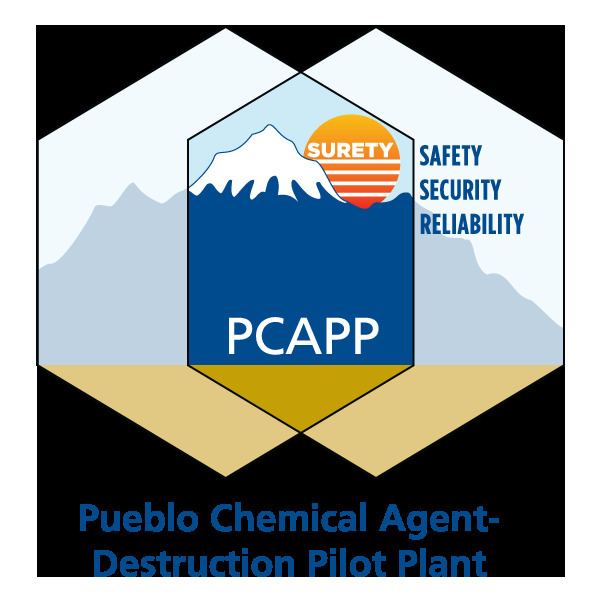 | ||
Roadmap to initiation of pueblo chemical agent destruction pilot plant operations
The Pueblo Chemical Agent-Destruction Pilot Plant (PCAPP) is a chemical weapons destruction facility that has been built to destroy the chemical weapons stockpile at the Pueblo Chemical Depot, in southeastern Colorado. The depot contains munitions containing 2,611 tons of mustard agent that are part of the U.S. national chemical weapons stockpile. The weapons have been stored at the 23,000-acre (93 km2) depot since the 1950s.
Contents
- Roadmap to initiation of pueblo chemical agent destruction pilot plant operations
- Baseline reconfiguration at the pueblo plant
- Planning of activities
- Technology
- Explosive Destruction Technology EDT
- Public outreach
- References
Destruction of this stockpile is a requirement of the Chemical Weapons Convention, an international treaty to which the United States is a party. The Organisation for the Prohibition of Chemical Weapons is the implementing body of the Chemical Weapons Convention and monitors the progress of the nation's chemical weapons destruction programs.
The Program Executive Office, Assembled Chemical Weapons Alternatives (PEO ACWA) oversees the destruction of the Pueblo chemical weapons stockpile.
Bechtel Pueblo Team (BPT; consisting of Bechtel National, Inc., URS and Battelle Memorial Institute) will design, construct, pilot test, operate and close PCAPP.
Baseline reconfiguration at the pueblo plant
Planning of activities
Destruction operations began in 2016 and are expected to be complete by 2019. The plant will operate until all the chemical weapons have been destroyed. Closure activities (shut-down, dismantling, and restoration of site) are slated to be completed by 2022.
In 2010, the Pueblo Chemical Depot, in conjunction with the ACWA program, completed an environmental assessment (EA) to meet the requirements of the National Environmental Policy Act, or NEPA, and Title 32 Code of Federal Regulations Part 651 regarding the construction and operation of the U.S. Army’s Explosive Destruction System (EDS) and/or other explosive destruction technologies (EDT), at the U.S. Army Pueblo Chemical Depot in Colorado. The EA was withdrawn and a new EA was completed in 2012. The new EA focused on the use of EDT for destroying overpacked and reject munitions. In April 2013, Program Executive Officer Conrad F. Whyne announced his selection of EDS to augment the Pueblo Chemical Agent-Destruction Pilot Plant for the safe destruction of chemical munitions unsuited for processing by the main plant’s automated equipment.
Technology
The Department of Defense conducted studies to evaluate potential impacts of the elimination of these weapons using incineration and non-incineration methods. Four technologies were considered:
Neutralization followed by biotreatment was selected for the destruction of the Colorado stockpile.
The technology comprises the following steps:
Explosive Destruction Technology (EDT)
After an assessment of problem munitions showed that their destruction would be difficult using neutralization and biotreatment, ACWA decided to explore use of Explosive Destruction Technology (aka Explosive Demolition Technology, Explosive Detonation Technology, EDT) for these projectiles.
EDT uses heat and pressure from explosion or just heat to destroy the munitions; it is not considered incineration and does not require disassembly of the weapons. There are three general types of technologies that can destroy chemical weapons:
In April 2013, Program Executive Officer Conrad F. Whyne announced his selection of the U.S. Army’s EDS to augment the PCAPP for the safe destruction of chemical munitions unsuited for processing by the main plant’s automated equipment.
The PCAPP EDS started processing on March 18 with the elimination of Department of Transportation (DOT) bottles which contain chemical agent drained from selected munitions over the years to assess the condition of the stockpile. On April 8, the first munitions were successfully processed. In June, operators at the PCAPP EDS took things up a notch with the introduction of 4.2-inch mortars into the destruction process. The first three mortars were joined by three 105 mm projectiles. All were safely detonated in the vessel on June 18. On July 16, the first 155 mm projectiles from Pueblo’s stockpile were safely destroyed in the PCAPP EDS. The PCAPP EDS completed its first campaign in February 2016, destroying 549 munitions that leaked or were sampled in the past and 11 bottles containing mustard agent. It will remain on stand-by to destroy any munitions rejected for automated processing in the main plant due to their condition.
Public outreach
The Pueblo Chemical Stockpile Outreach Office was established in 1997 to serve as the community’s primary information resource on chemical weapons destruction in Colorado. The office responds to inquiries, provides information materials and coordinates guest speakers for a variety of different civic groups and organizations and interfaces with the governor-appointed Colorado Chemical Demilitarization Citizens’ Advisory Commission.
